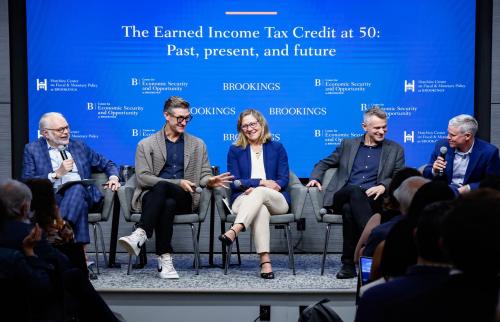This post was updated on January 3, 2022 to clarify that COVID-19 booster rates are the percent of residents and staff that have completed the primary vaccination series—not the percent of all residents and staff—who have received a booster.
The arrival of the Omicron variant of the COVID-19 virus has solidified the need for COVID-19 vaccine boosters. The CDC first recommended boosters for nursing home residents and other high-risk populations in late September, but newly-released data show that residents and staff have been slow to get boosted. Only 58% of vaccinated nursing home residents and 25% of vaccinated staff have received a booster dose, although the data are reported with a two-week lag and the trend is positive. In a post last summer, we showed that vaccination for nursing home residents had not been politicized as much as for younger populations. Here, we update our earlier analysis to look at booster uptake and show that, despite the ever-increasing politicization of COVID-19 vaccination in the general population, booster uptake among nursing home residents still has not been strongly politicized.
Figure 1 shows the relationship between Trump’s two-party vote share and the share of the population that has completed the primary COVID-19 vaccine series. As has been widely discussed, vaccination rates are lower in states where Trump won a larger share of votes. But, as we noted in our earlier post, this relationship is weaker for older adults, who face a much higher risk of severe outcomes from COVID-19 infection. Vaccination rates have increased for all groups since our August post, but the strength of the relationship between Trump vote share and vaccination rate has hardly changed for teens, non-elderly adults, and the elderly. The vaccine is now approved for children five to eleven, and according to CDC data, about 17% of children in that age group had received a first dose by December 5. Predictably, take-up was lower in states with high Trump vote shares.
 Sources: COVID-19 Vaccinations in the United States, by Jurisdiction; MIT Election Data and Science Lab U.S. President 1976–2020 .
Sources: COVID-19 Vaccinations in the United States, by Jurisdiction; MIT Election Data and Science Lab U.S. President 1976–2020 .
By contrast, we showed that the share of nursing home residents who were fully vaccinated–according to the original two-dose series–was not lower in high Trump-vote-share states and was instead highly correlated with pre-pandemic flu vaccination rates. Nursing home residents were the first to get access to COVID-19 vaccines starting in late 2020, so it is possible many completed the primary series before vaccination became so politicized. If that were the case, then we might expect that boosters for nursing home residents, which were given later, would also show the influence of this politicization. Fortunately, the new data for boosters suggest this did not happen. The first panel of Figure 2 shows that the share of vaccinated nursing home residents who are boosted according to the most recent data is unrelated to Trump vote share, and in four of the five most-boosted states, Trump won. The second panel shows that a state’s pre-pandemic flu vaccination rate for nursing home residents, which was highly correlated with initial vaccination rates, continues to be a strong predictor of the share receiving boosters for COVID-19.
 Sources: National Healthcare Safety Network (NHSN) COVID-19 Long Term Care Facility Module; MIT Election Data and Science Lab U.S. President 1976–2020; Vaccination Coverage among Nursing Home Residents
Sources: National Healthcare Safety Network (NHSN) COVID-19 Long Term Care Facility Module; MIT Election Data and Science Lab U.S. President 1976–2020; Vaccination Coverage among Nursing Home Residents
Nursing homes in some states are consistently more able to deliver life-saving vaccines to residents, whether it is annual flu vaccines, the primary COVID-19 series, or COVID-19 boosters. Little is known about what explains these state-level differences–which could be related to differences in state-level policy; nursing home funding, staffing, or practices; or the characteristics of residents. The fact that vaccination in nursing homes has not become as tied to political identity as in the general population is promising, but addressing the longstanding underlying barriers to effectively delivering vaccines is also a challenge. To improve vaccination rates in nursing homes over the long term, more should be done to understand why some states lag and to develop interventions or policies that work to reduce vaccine hesitancy in nursing home residents and staff.
The share of nursing home staff who have completed the primary COVID-19 vaccine series has increased substantially from about 61% in August to 78% now, but rates have increased more in lower-Trump-share states, where they were already higher (Figure 3). Only 25% of vaccinated nursing home staff have been boosted; so far, the correlation between the share of nursing home staff who have been boosted and Trump vote share is weaker, but still negative, and the relationship will likely strengthen as the share boosted rises.
 Sources: National Healthcare Safety Network (NHSN) COVID-19 Long Term Care Facility Module; MIT Election Data and Science Lab U.S. President 1976–2020
Sources: National Healthcare Safety Network (NHSN) COVID-19 Long Term Care Facility Module; MIT Election Data and Science Lab U.S. President 1976–2020
Unfortunately, there is little time to get more nursing home residents and staff boosted before Omicron arrives. Most nursing homes report having sufficient supplies for testing, and there are so far no indications that personal protective equipment (PPE), such as N95 masks, are in short supply. Hopefully, nursing homes can use these tools to limit the spread of Omicron until more residents are fully boosted. Considering the evidence that boosters can reverse waning immunity and that death rates are elevated in facilities with low staff vaccination rates, boosting nursing home residents and staff, especially in areas that have not yet been impacted by Omicron, should be a high priority.
The Brookings Institution is committed to quality, independence, and impact.
We are supported by a diverse array of funders. In line with our values and policies, each Brookings publication represents the sole views of its author(s).






